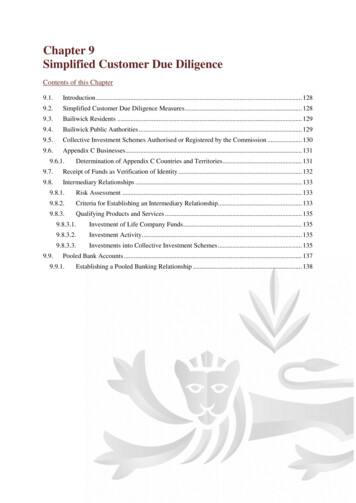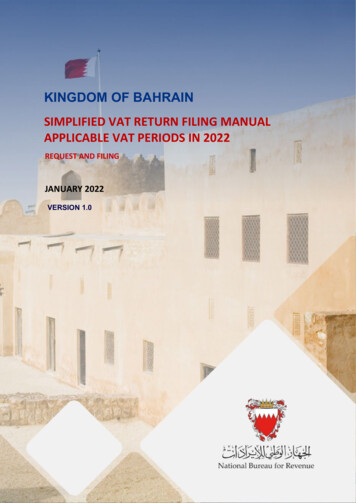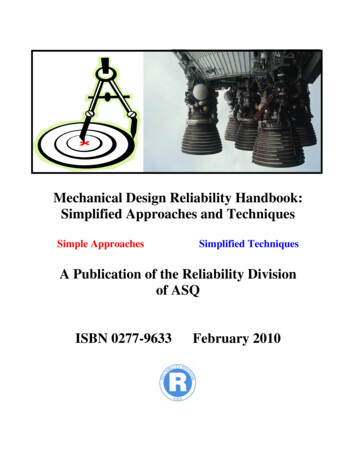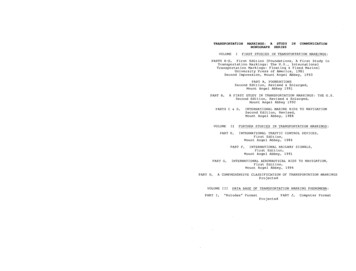
Transcription
Chapter 9Simplified Customer Due DiligenceContents of this Chapter9.1.Introduction . 1289.2.Simplified Customer Due Diligence Measures . 1289.3.Bailiwick Residents . 1299.4.Bailiwick Public Authorities . 1299.5.Collective Investment Schemes Authorised or Registered by the Commission . 1309.6.Appendix C Businesses. 1319.6.1.Determination of Appendix C Countries and Territories . 1319.7.Receipt of Funds as Verification of Identity . 1329.8.Intermediary Relationships . 1339.8.1.Risk Assessment . 1339.8.2.Criteria for Establishing an Intermediary Relationship. 1339.8.3.Qualifying Products and Services . 1359.9.9.8.3.1.Investment of Life Company Funds. 1359.8.3.2.Investment Activity . 1359.8.3.3.Investments into Collective Investment Schemes . 135Pooled Bank Accounts . 1379.9.1.Establishing a Pooled Banking Relationship . 138
9.1.IntroductionThis Chapter provides for the treatment of business relationships and occasional transactionswhich have been assessed as being low risk relationships pursuant to Paragraph 3 of Schedule 3and Chapter 3 of this Handbook. It sets out the ability to apply SCDD measures to businessrelationships or occasional transactions in specific circumstances and defines those simplifiedmeasures which can be applied.This Chapter should also be read in conjunction with Chapters 4 to 7 of this Handbook whichprovide for the overarching CDD obligations and the specific requirements for the differingcategories of natural persons, legal persons and legal arrangements with which the firm coulddeal as part of a business relationship or occasional transaction.9.2.Simplified Customer Due Diligence MeasuresThe general rule is that business relationships and occasional transactions are subject to the fullrange of CDD measures as set out in Schedule 3 and this Handbook, including the requirementto identify and verify the identity of the customer and to identify and take reasonable measuresto verify the identity of the beneficial owner.However, there may be circumstances where the risks of ML and FT have been assessed by thefirm as being low. Examples could include:(a)(b)(c)a Bailiwick resident customer where the purpose and intended nature of the businessrelationship or occasional transaction is clearly understood by the firm;a business relationship or occasional transaction where the risks associated with therelationship are inherently low and information on the identity of the customer andbeneficial owner is publicly available, or where adequate checks and controls existelsewhere in publicly available systems; ora business relationship or occasional transaction in which the customer is an Appendix Cbusiness.There may also be circumstances where the risk of ML and FT has been assessed as low by theBailiwick as part of its NRA. In these circumstances, the firm may consider applying SCDDmeasures when identifying, and verifying the identity of, the customer and beneficial owner.National Risk AssessmentIn accordance with Paragraph 6(1) of Schedule 3, where the firm is required to carry out CDD inrelation to a business relationship or occasional transaction which has been assessed as a lowrisk relationship pursuant to Paragraph 3(4)(a) or in accordance with the NRA, it may, subject tothe provisions of Paragraphs 6(2) and 6(3) of Schedule 3, apply reduced or SCDD measures.In accordance with Paragraph 6(2) of Schedule 3, the discretion in Paragraph 6(1) as set outabove may only be exercised by the firm:(a)(b)in accordance with the requirements set out in this Handbook, andwhere it complies with the requirements of Paragraph 3 of Schedule 3.The SCDD measures applied by the firm should be commensurate with the low risk factors andshould relate only to relationship acceptance measures or to aspects of ongoing monitoring(excluding sanctions screening). Examples of possible measures could include:Chapter 9 - Page 128
(a)(b)(c)reducing the verification measures applied to the customer and/or beneficial owner, inaccordance with the following sections of this Chapter;reducing the degree of on-going monitoring and scrutiny of transactions, based on areasonable monetary threshold; ornot collecting specific information or carrying out specific measures to understand thepurpose and intended nature of the business relationship or occasional transaction, butinferring the purpose and nature from the type of transaction(s) or business relationshipestablished.The firm must ensure that, when it becomes aware of circumstances which affect the assessed riskof a business relationship or occasional transaction to which SCDD measures have been applied,a review of the relationship risk assessment is undertaken and a determination is made as towhether the identification data held remains appropriate to the revised risk of the businessrelationship or occasional transaction.Where the firm has taken a decision to apply SCDD measures, documentary evidence must beretained which reflects the reason for the decision. The documentation retained must providejustification for the decision, including why it is deemed acceptable to apply SCDD measureshaving regard to the circumstances of the business relationship or occasional transaction and therisks of ML and FT.In accordance with Paragraph 6(3) of Schedule 3, for the avoidance of doubt, the discretion toapply SCDD measures shall not be exercised:(a)(b)where the firm forms a suspicion that any party to a business relationship or occasionaltransaction or any beneficial owner is or has been engaged in ML or FT, orin relation to a business relationship or occasional transaction where the risk is other thanlow.9.3.Bailiwick ResidentsWhere the customer, beneficial owner or other key principal to a business relationship oroccasional transaction is a natural person resident in the Bailiwick, the firm may apply SCDDmeasures in respect of that natural person, provided the requirements as set out in Section 9.2.above are met. Where the firm has determined that it can apply SCDD measures because the riskhas been assessed as low, it may elect to verify one of points (b) date of birth and (c) residentialaddress under Commission Rule 5.8., in addition to (a) legal name.Notwithstanding the above, it should be borne in mind that not all Bailiwick residents areintrinsically low risk. The firm must ensure that a relationship risk assessment is undertaken inaccordance with the requirements of Paragraph 3 of Schedule 3 and Chapter 3 of this Handbookand that where the business relationship or occasional transaction is considered to be other thanlow risk, that the appropriate CDD, and where necessary ECDD, measures are applied.9.4.Bailiwick Public AuthoritiesWhere the customer, beneficial owner or other key principal to a business relationship oroccasional transaction has been identified as a Bailiwick public authority, the firm may chooseto apply SCDD measures in respect of that public authority. Where SCDD measures are applied,it is not necessary for the firm to apply full verification measures to the public authority (and thebeneficial owners thereof), other than where the firm considers this course of action appropriatein the circumstances.Chapter 9 - Page 129
The firm must identify, and verify the identity of, the Bailiwick public authority, including as aminimum:(a)(b)(c)(d)the full name of the public authority;the nature and status of the public authority;the address of the public authority; andthe names of the directors (or equivalent) of the public authority.The following are examples of Bailiwick public authorities:(a)(b)(c)(d)a government department;an agency established by law;a parish authority/douzaine; anda body majority owned by an authority listed in points (a) to (c) above.Where a natural person authorised to act on behalf of a Bailiwick public authority is acting in thecourse of employment, it is not necessary to identify and verify the identity of that person.However, the firm should verify the natural person’s authority to so act.It may be that an individual acting on behalf of a Bailiwick public authority falls within thedefinition of a domestic PEP. However, in the context of acting for the Bailiwick publicauthority, the individual is directing funds belonging to the authority and not their personal funds.The firm may therefore determine that the measures required under Commission Rule 9.15. aresufficient and that the prominent public function held by the natural person does not pose anincreased risk to the firm in the context of the business relationship or occasional transactionwith the Bailiwick public authority.9.5.Collective Investment Schemes Authorised or Registered by the CommissionWhere the customer, beneficial owner or other key principal to a business relationship oroccasional transaction is a CIS authorised or registered by the Commission, the firm (other thanwhere it has been nominated as the party responsible for applying CDD measures to investors inaccordance with Section 4.8.1. of this Handbook) may consider the CIS to be the principal forthe purposes of the firm’s CDD measures.Where this is the case, in verifying the identity of the CIS the firm must, as a minimum, obtaindocumentation which confirms the CIS is authorised or registered by the Commission.Further information about CISs authorised and registered by the Commission can be found on theCommission’s tment/regulated-entitiesWhere a natural person authorised to act on behalf of a CIS to which this Section applies is doingso in the course of employment with that CIS or its Designated Manager, it is not necessary toidentify and verify the identity of that person. However, the firm should verify the person’sauthority to act on behalf of the CIS.As an example, where a bank is opening an account for a CIS authorised or registered by theCommission, the bank may treat the CIS as the customer to be identified and verified.Chapter 9 - Page 130
9.6.Appendix C BusinessesAppendix C to this Handbook lists those countries or territories which the Commission considersrequire regulated FSBs, and in limited circumstances PBs, to have in place standards to combatML and FT consistent with the FATF Recommendations and where such businesses areappropriately supervised for compliance with those requirements. Appendix C is reviewedperiodically with countries or territories being added or removed as appropriate.The fact that a country or territory has requirements to combat ML and FT that are consistentwith the FATF Recommendations means only that the necessary legislation and other means ofensuring compliance with the FATF Recommendations are in force in that country or territory.It does not provide assurance that a particular overseas business is subject to that legislation, orthat it has implemented the necessary measures to ensure compliance with that legislation.The inclusion of a country or territory in Appendix C does not mean that the country or territoryin question is intrinsically low risk, nor does it mean that any business relationship or occasionaltransaction in which the customer or beneficial owner has a connection to such a country is to beautomatically treated as a low risk relationship.Where the customer has been identified as an Appendix C business and the purpose and intendednature of the business relationship or occasional transaction is understood, subject to CommissionRule 9.28. and with the exception of the circumstances set out in Paragraph 9.31. below,verification of the identity of the Appendix C business is not required.With the exception of the provisions in Sections 9.8. and 9.9. of this Chapter, if the Appendix Cbusiness is acting for or on behalf of another party the firm must, in accordance with Paragraph4(3)(d) of Schedule 3, take reasonable measures to identify and verify the identity of that thirdparty in accordance with the requirements of Schedule 3 and this Handbook.Where a natural person authorised to act on behalf of an Appendix C business is doing so in thecourse of employment with that business, it is acceptable for the firm not to identify and verifythe identity of that person. However, the firm should verify the person’s authority to act on behalfof the Appendix C business. One such example would be a director (or equivalent) of a Bailiwickfiduciary who is acting in the course of his fiduciary obligations or an administrator executinginstructions on behalf of a CIS.The firm is not obliged to deal with regulated FSBs or PBs in the jurisdictions listed in AppendixC as if they were local, notwithstanding that they meet the requirements identified in AppendixC. The firm may, in deciding whether or not to deal with a regulated FSB or PB, impose higherstandards than the minimum standards identified in this Handbook where it considers thisnecessary.The provisions in this Section cannot be applied to an Appendix C business (other than a trustand corporate service provider licensed by the Commission) which, acting as the trustee of a trust,is the customer or other key principal to a business relationship or occasional transaction.9.6.1.Determination of Appendix C Countries and TerritoriesIn accordance with Paragraph 16(2) of Schedule 3, when exercising its functions the Commissionmust take into account information, or in relation to:(a)the ML and FT risk associated with particular countries, territories and geographic areas;andChapter 9 - Page 131
(b)the level of cooperation it expects to receive from relevant authorities in those countries,territories and areas.In making its determination of those jurisdictions listed in Appendix C, in addition to the factorsset out in Paragraph 16(2) of Schedule 3, the Commission will also take into consideration severalother factors including:(a)(b)(c)(d)(e)the jurisdiction’s membership of the FATF and/or a FATF-style regional body;reports and assessments by the FATF and/or other regional body for compliance with theFATF Recommendations;good governance indicators;the level of drug trafficking, bribery and corruption and other financial and organised crimewithin the jurisdiction; andthe extent of terrorism and terrorist financing activities within the jurisdiction.When reviewing assessments undertaken by the FATF or other FATF-style regional bodies of acountry/territory’s compliance with the FATF Recommendations, particular attention is given to:(a)(b)the findings, recommendations and ratings of compliance with the FATFRecommendations (in particular Recommendations 10, 11 and 12); andthe findings, recommendations and ratings of effectiveness of the country or territory’sAML and CFT regime against the FATF’s eleven ‘Immediate Outcomes’ set out within itsmethodology for compliance with the FATF Recommendations.9.7.Receipt of Funds as Verification of IdentityWhere the customer and beneficial owner have been identified and the business relationship oroccasional transaction is considered to be low risk, the firm may consider the receipt of funds toprovide satisfactory means of verifying identity.In order to utilise this provision, the firm must ensure that:(a)(b)(c)(d)(e)all initial and future funds are received from an Appendix C business;all initial and future funds come from an account in the sole or joint name of the customeror beneficial owner;payments are only paid to an account in the customer’s name (i.e. no third party paymentsallowed), or in respect of real estate transactions, to an account in the name of the vendorof the property or in the name of the legal professional acting on behalf of the purchaser;no changes are made to the product or service that enable funds to be received from or paidto third parties; andno cash withdrawals are permitted other than by the customer, or a beneficial owner, on aface-to-face basis where the identity of the customer or beneficial owner can be confirmed,and in the case of significant cash transactions, the reasons for cash withdrawal are verified.The firm must ensure that, once a business relationship has been established, should any of theconditions set out in Commission Rule 9.36. no longer be met, full verification of the identity ofthe customer and beneficial owner is carried out in accordance with the requirements of Schedule3 and this Handbook.Should the firm have reason to suspect the motives behind a particular transaction or believe thatthe business relationship or occasional transaction is being structured to avoid the firm’s standardCDD measures, it must ensure that the receipt of funds is not used to verify the identity of thecustomer or beneficial owner.Chapter 9 - Page 132
The firm must retain documentary evidence to demonstrate the reasonableness of its conclusionthat the risk of the business relationship being established or the occasional transaction beingundertaken is low.9.8.Intermediary RelationshipsAn intermediary relationship is where the firm enters into a business relationship with anintermediary who is acting for or on behalf of its customers and where the business relationshipthe firm has is with the intermediary and not the intermediary’s customers. If the firm hasassessed the ML and FT risks of the relationship with the intermediary as low, it may, subject tocertain criteria being met and only in respect of certain qualifying products and services, treat theintermediary as its customer for CDD purposes, instead of identifying and verifying the identityof the intermediary’s customer(s).The firm should be aware that money launderers are attracted by the availability of complexproducts and services that operate internationally within a reputable and secure financial servicesenvironment. In this respect, the firm should be alert to the risk of an intermediary relationshipbeing used to mask the true beneficial ownership of an underlying customer for criminalpurposes.Section 9.8.2. of this Handbook sets out the criteria which must be met for an intermediaryrelationship to be established by the firm. In such cases the firm will not have a direct relationshipwith the intermediary’s customer and it will therefore not be necessary to apply CDD measuresto the intermediary’s customers, unless the firm considers this course of action to be appropriatein the circumstances. The intermediary does however have a direct relationship with itscustomer.9.8.1.Risk AssessmentBefore establishing an intermediary relationship, the firm must undertake a relationship riskassessment of the proposed business relationship with the intermediary.Such an assessment will allow the firm to determine the risk in placing reliance on anintermediary and to consider whether it is appropriate to treat the intermediary as the firm’scustomer or whether it feels the risk would be better managed if it were to:(a)(b)treat the intermediary as an introducer in accordance with Chapter 10 of this Handbook;orapply CDD measures to the customer (including the beneficial owner and other keyprincipals) for whom the intermediary is acting.Chapter 10 of this Handbook provides for the identification and verification requirements inrelation to introduced business relationships, i.e. where an Appendix C business enters into abusiness relationship with the firm on behalf of one or more third parties, who are its customers.9.8.2.Criteria for Establishing an Intermediary RelationshipWhen establishing an intermediary relationship, the firm must apply CDD measures to theintermediary to ensure that the intermediary is either:(a)(b)an Appendix C business; ora wholly owned nominee subsidiary vehicle of an Appendix C business which applies thepolicies, procedures and controls of, and is subject to oversight from, the Appendix Cbusiness;Chapter 9 - Page 133
excluding a trust and corporate service provider unless that trust and corporate service provider islicensed under the Fiduciary Law.Where the condition in Commission Rule 9.46. is met and the business relationship with theintermediary has been assessed as being low risk, the firm can exercise its own judgement in thecircumstances as to the level of CDD measures to be applied to the intermediary. However, at aminimum the firm must:(a)(b)identify and, subject to the provisions of Section 9.6. of this Handbook, verify the identityof the intermediary; andreceive written confirmation from the intermediary which:(i)(ii)(iii)(iv)confirms that the intermediary has appropriate risk-grading procedures in place todifferentiate between the CDD requirements for high risk relationships and low riskrelationships;contains adequate assurance that the intermediary applies appropriate and effectiveCDD measures in respect of its customers, including ECDD measures for PEPs andother high risk relationships;contains sufficient information to enable the firm to understand the purpose andintended nature of the intermediary relationship; andconfirms that the account will only be operated by the intermediary and that theintermediary has ultimate, effective control over the relevant product or service.Where an intermediary relationship has been established, the firm must prepare and retaindocumentary evidence of the following:(a)(b)(c)the adequacy of its process to determine the risk of the intermediary relationship and thereasonableness of its conclusions that it is a low risk relationship;that it has applied CDD measures to the intermediary; andthat the intermediary relationship relates solely to the provision of products or serviceswhich meet the requirements of Section 9.8.3. below.In circumstances where the criteria for an intermediary relationship are not completely satisfiedor are no longer met (for example, because the proposed intermediary is not an Appendix Cbusiness or the risk of the intermediary relationship has been assessed as being other than low)then the relationship must not be considered as an intermediary relationship.Where the firm has determined, in accordance with Commission Rule 9.49., that it cannot treat anintermediary as the customer, the firm must treat the underlying customers of the intermediary asif they were the firm’s customers and must apply its own CDD measures in accordance with therequirements of Schedule 3 and this Handbook.The firm should always consider whether the risk would be better managed if it applied CDDmeasures to the person or legal arrangement, including the beneficial owner and other keyprincipals, for whom the intermediary is acting rather than treating the intermediary as itscustomer.The following are examples of steps the firm could take where, in accordance with CommissionRule 9.50., the firm is required to apply CDD measures to an intermediary’s customers:(a)open individual accounts in the names of each of the customers on behalf of whom theintermediary was acting and apply CDD measures to each of those customers, includingthe beneficial owners and other key principals; orChapter 9 - Page 134
(b)9.8.3.open an account in the name of the intermediary, provided that the firm also receives acomplete list of the underlying customers from the intermediary to allow it to apply itsown CDD measures to those customers, including the beneficial owners and other keyprincipals.Qualifying Products and ServicesFor an intermediary to be considered as the customer of the firm, the intermediary relationshipmust be for the provision of one of the following products and services:Investment of life company funds to back the life company’s policyholder liabilities wherethe life company opens an account (see Section 9.8.3.1. below);(b) Undertaking various restricted activities by a POI licensee, as part of its relationship fallingwithin the scope of the POI Law, with another regulated FSB where the funds (and anyincome) may not be returned to a third party unless that third party was the source of funds(see Section 9.8.3.2. below); or(c) Investments into a CIS or NGCIS (for example, by a discretionary or advisory investmentmanager or custodian) acting in its own name and as the registered owner of the shares orunits of the CIS (see Section 9.8.3.3. below); or(c)(d) The offering of insurance products to another regulated FSB by a Guernsey licensed insurer,as part of its relationship falling within the scope of The Insurance Business (Bailiwick ofGuernsey) Law, 2002 as amended. .(a)9.8.3.1. Investment of Life Company FundsWhere the firm is licensed under the Banking Law and provides services to a life insurancecompany through the opening of an account for the investment of funds to back the lifecompany’s policyholder liabilities, the firm can treat the life insurance company as its customer.Where the firm is licensed under the POI Law and a life insurance company is investing its policyholder funds into a CIS authorised or registered by the Commission or an NGCIS, the firm cantreat the life insurance company as its customer.If the account or investment has a policy identifier then the firm must require an undertaking fromthe life company that it is the legal and beneficial owner of the funds and that the policyholder hasnot been led to believe that he or she has rights over an account or investment in the Bailiwick.9.8.3.2. Investment ActivityWhere the firm is licensed under the POI Law and undertakes various restricted activities withinthe scope of its licence as part of its relationship with another regulated FSB, the firm can treatthat regulated FSB as its customer.Where the firm utilises these provisions, any funds received from the intermediary (and anyincome resulting from the investment of such) must not be returned to a third party, unless thatthird party was the source of the funds and the firm is satisfied that the involvement of the thirdparty does not pose an increased ML or FT risk.9.8.3.3. Investments into Collective Investment SchemesWhere the firm has been nominated in accordance with Paragraph 4.57. and an investment ismade into a CIS or NGCIS (referred to in this section as a “CIS”) by an intermediary, forexample, a discretionary or advisory investment manager or custodian acting in its own nameChapter 9 - Page 135
and as the registered owner of the shares as set out in Section 4.8.2. of this Handbook, thenominated firm can treat the intermediary as its customer.Investments made into a CIS via an intermediary as described under Commission Rule 4.70.(b)(c), where the identity of the underlying investors is not disclosed to the CIS or the nominatedfirm, is common practice within the fund sector across the world and is recognised withinguidance issued by IOSCO, the Basel Committee on Banking Supervision and in the EuropeanSupervisory Authorities’ (“ESAs”) Risk Factors Guidelines issued under the Fourth Anti-MoneyLaundering Directive.Notwithstanding the above, the ability for an underlying investor to invest into a CIS on anundisclosed basis increases the risk of a CIS being abused for ML or FT purposes. This isparticularly relevant where there are a very limited number of investors in a CIS who couldexercise control over the assets of that CIS, either through ownership or by other means. In thisrespect it is possible for an individual person or family office to hold, via an intermediary orintermediaries, more than 25% of the shares/units or voting rights of a CIS, or exercise controlthrough other means, which as identified under the Bailiwick’s Beneficial Ownership regime,would classify the underlying investor as a beneficial owner, but their identity would not beknown.The nominated firm should be aware that certain types of CIS, such as hedge funds, real estateand private equity funds, tend to have a smaller number of investors which can be privateindividuals as well as institutional investors, for example, pension funds or funds of funds. CISsthat are designated for a very limited number of high-net-worth individuals or family offices canhave an inherently higher risk of abuse for ML and/or FT purposes as compared to retail orinstitutional funds. In such cases, underlying investors are more likely to be in a position toexercise control over the CIS and use the CIS as a personal asset holding vehicle.Personal asset holding vehicles should not be authorised/registered under the POI Law, asParagraph 1(1)(b) of Schedule 1 to the POI Law states, inter alia:‘a CIS is any arrangement relating to property of any description (including money) inwhich the investors do not have a day-to-day control over the management of the propertyto which the arrangement relates (whether or not they have any right to be consulted orgive directions)’.However, the nominated firm should be aw
9.2.Simplified Customer Due Diligence Measures The general rule is that business relationships and occasional transactions are subject to the full range of CDD measures as set out in Schedule 3 and this Handbook, including the requirement to identify and verify the identity of the customer and to identify and take reasonable measures










